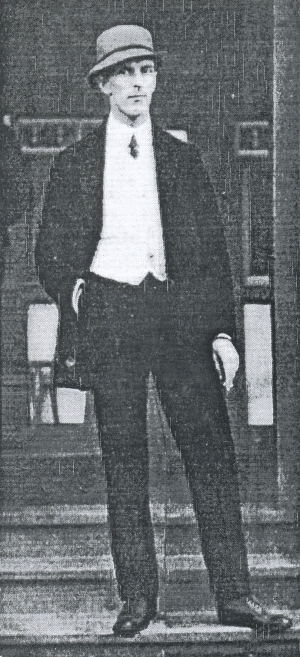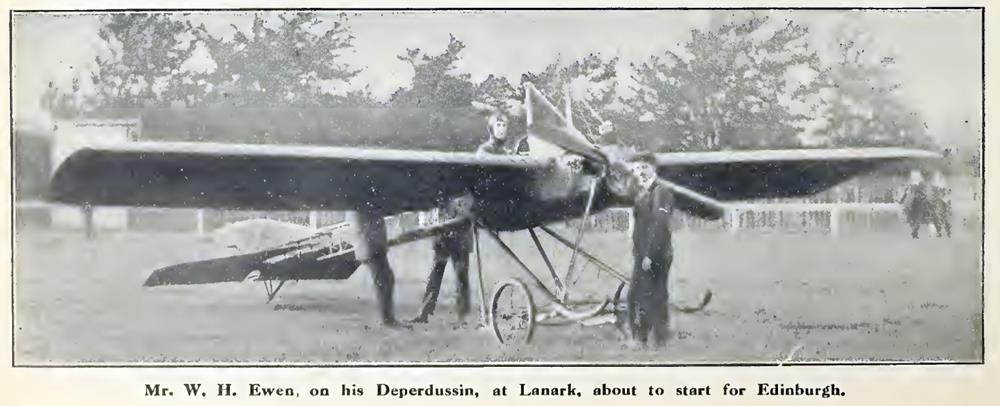1911 – First Flight across the Forth
| < British Naval Aviation | Δ Index | Royal Aircraft Factory > |
Not long after the naval aviators had gained their “wings”, a Scottish aviator made the first flight across the River Forth.
September 7, 1911 – First heavier-than-air powered flight across the Forth. 28 miles – 45 km

W. H. Ewen, the Scottish aviator, on Wednesday, August 30th, flew from the Marine Gardens, Portobello, near Edinburgh, across the Firth of Forth, and back again to the Gardens. At about 300 feet, he made for Kinghorn, leaving Inchkeith on his right. He appeared to find the wind troublesome at this altitude, and rose again till he was about 1,000 feet up. Past Inchkeith, Ewen found himself in an almost dead calm, and held on till about a mile from Kinghorn, where he turned up the Firth towards Leith.
Two miles from the Port he again turned and came back to the Marine Park. The crowd had greatly increased, and as the aviator appeared he was loudly cheered. He descended, but seeing he could not land in such a restricted area he went over the heads of the crowd and landed in a field about a mile to the west. There he had the planes taken off and the machine wheeled back to the enclosure.
On his return to the Park, Ewen had a most enthusiastic reception. “See the Conquering Hero Comes” was played, by the band of the 3rd Dragoon Guards, and Councillor Rawson, on behalf of the Executive, met him at the Members’ Club and congratulated him on his success. A speech was called for, and in a few words he expressed his pleasure with, the manner in which his flight had been received. He was glad that a Scotsman had been able to do something. His mother and father witnessed his flight.
Ewen is a graduate of Edinburgh University, and is organist at Park Parish Church, Glasgow. He only took up aviation this year, but he made remarkable progress at Hendon. He flew at his first attempt, and gained his pilot’s certificate at his third flight. This is a record for Hendon.
Writing to The Aeroplane in answer to a letter, Mr. Ewen says: “This, I believe, is really the longest distance [about 28 miles.— Ed.] attempted over water with such a low hp (28-32 Anzani) since Bleriot crossed the Channel. The machine was delivered to me in a hurry, and had not been previously flown. I had no chance for trial flights, and only had 150 yards to rise in and clear a fence of 15 feet. I am pleased, however, with the way in which the Deperdussin flies and handles. I am being presented with a large silver cup by the Edinburgh Marine Gardens in honour of the event.”
“I am soon taking the machine back to Lanark, where I expect to put at least two pupils through during the next week for R.Ae.C. certificates. I have two splendid mechanics in the school looking after things, that I may be thoroughly up to date, one of them, Mr. Warren, from the Hendon Aerodrome, being responsible for the splendid running of my engine on Wednesday.”
In the morning, by way of practice, Ewen had done a mile cross-country flight. Shortly after six a.m. he started from the sports enclosure, after a run of about 150 feet, and steered, seawards towards Leith. Circling round by Seafield, Ewen passed over the golf course at Craigentinny and turned inland, to Duddingston and Joppa. His intention was to fly back to the Marine Park, but near the golf course at Portobello the wind became troublesome, and he was obliged to descend on Northfield Farm. At one point he rose to 700 feet, but his average altitude during the flight was about 350 feet.
It is to be hoped that after so fine a performance aviation, will become popular in Scotland, and that the Lanark Aerodrome will find plenty of pupils.
 Ewen’s Deperdussin Monoplane at Lanark, 1911
Ewen’s Deperdussin Monoplane at Lanark, 1911
Ewen’s flight over the Forth demonstrated that aircraft had become much more manoeuvrable, he was able to fly across the river, turn, fly downstream, turn back and then circle to identify a suitable landing field.
| < British Naval Aviation | Δ Index | Royal Aircraft Factory > |